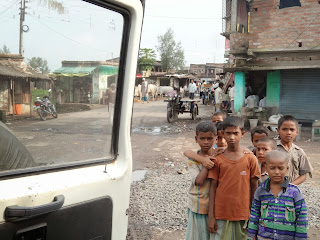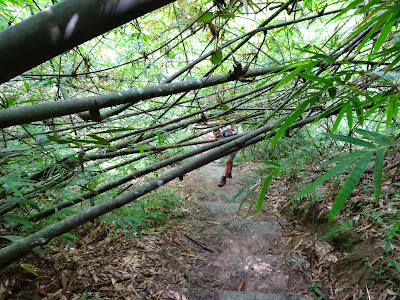With train travel being so cheap and Kolkata being a night-train ride away from the foot of the Himalaya, it would seem unreasonable not to send a weekend in the mountains. Darjeeling was one of the first hill stations estabished by the British in India, and it was here that they left arguably their greatest contribution to Indian culture - tea making (their other most obvious contribution being cricket, which let's be honest, sucks). With fresh air and fresh tea on offer, it seemed like the perfect break from the madness of Kolkata.
The journey to Darjeeling doesn't get interesting until you hop off the train in Siliguri and get into a jeep which begins to climb up from the incredibly flat Indian Plateau into the green foothills of the Himalaya. After three hours of winding through the tea plantations, which cover these steep hills, we arrived in Darjeeling. Darjeeling feels a lot more Nepalese than Indian (which makes lots of sense if you look for it on a map...) - the people look different, there are big lovely mountains around, there is a significant Buddhist community, and even the streets are cleaner with slightly less flea-bitten dogs. Oh, and the nicest difference by far - it's actually cold up there.
Next time: Back to the squalor of Kolkata for more volunteering.
The journey to Darjeeling doesn't get interesting until you hop off the train in Siliguri and get into a jeep which begins to climb up from the incredibly flat Indian Plateau into the green foothills of the Himalaya. After three hours of winding through the tea plantations, which cover these steep hills, we arrived in Darjeeling. Darjeeling feels a lot more Nepalese than Indian (which makes lots of sense if you look for it on a map...) - the people look different, there are big lovely mountains around, there is a significant Buddhist community, and even the streets are cleaner with slightly less flea-bitten dogs. Oh, and the nicest difference by far - it's actually cold up there.
First impression of Indian night-trains: Actually pretty good! Got a fairly decent sleep, without getting anything stolen. Only complaints were the guy that came round 6 times yelling "CHIP CHIP, POTATO CHIP ABAILABLE", and the amount of people pooping beside the train tracks in the morning.
Looking out towards the hazy Indian plains from the Himalayan foothills.
A view of Darjeeling from the Happy Valley Tea Estate - Darjeeling's highest tea plantation.
It's not called Happy Valley Tea Estate for nothing. We were the happiest of hobbits as we skipped down the pebbled mountain path with the wind in our hair, the sun on our face, and joy in our hearts.
This is where they dry the tea leaves. It smells like a fresh grassy delicious cuppa!
Our group was tricked into sampling "the best 5-second tea in all of India" by India's greatest hustler, a little old lady who had set up business right outside Happy Valley, selling their cheapest grade of tea possible. It was average at best.
At 5am every morning there is a mass exodus of tourists from Darjeeling to Tiger Hill, one of the best view points for the Himalaya around here. Fighting through the crowds is absolutely worth it to see the sun rise over Kangchenjunga (3rd highest mountain in the world) and all his magnificent friends.

Being white and a head taller than everyone else at Tiger Hill meant we got assaulted by hoards of camera-wielding Indians wanting photos with us. At first it was amusing, but it quickly turned into a competition for who could ruin the photo the most without them noticing.

Being white and a head taller than everyone else at Tiger Hill meant we got assaulted by hoards of camera-wielding Indians wanting photos with us. At first it was amusing, but it quickly turned into a competition for who could ruin the photo the most without them noticing.
Buddhists sure know how to build epic monasteries. Not only that, but they know how to pick the most epic places to build monasteries too.
The Japanese Peace Pagoda was super stunning, with depictions of the phases of Buddha's life carved around the Pagoda's dome. We even got to join in on a mesmerising drumming session with some resident monks.
We paid $2 per night for our beds. They were very damp, and we had to keep the bathroom door shut or the whole place would reek of bad things. We did find a way to entertain ourselves though - Darjeeling's newest sport, "Flappy-trouser Fighting". Phoebe: 2 - Felix: 0
First impression of Indian night-buses: Absolutely awful. The roads were so bumpy we were bounced around like popcorn for 21 hours (6 hours more than promised?!!) in a tiny space which we couldn't even sit up in. Never again.
Next time: Back to the squalor of Kolkata for more volunteering.




















































